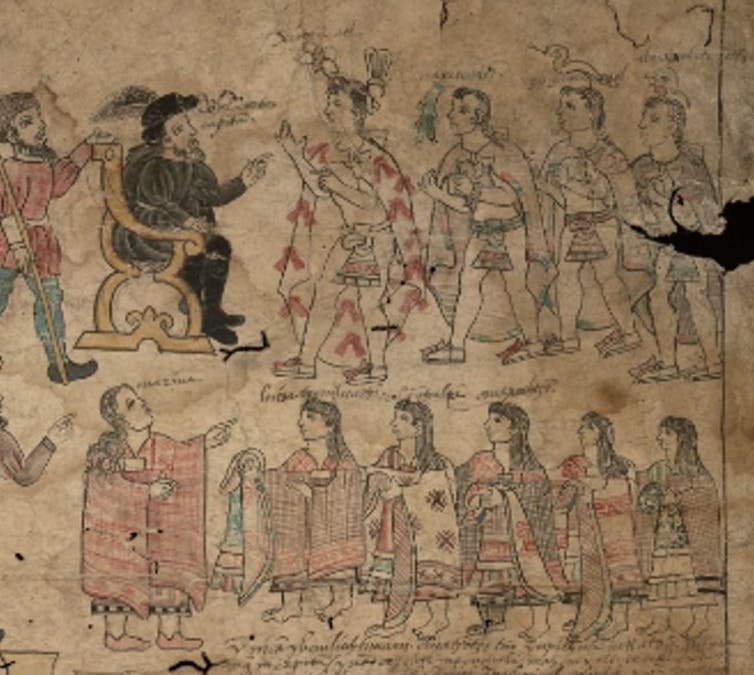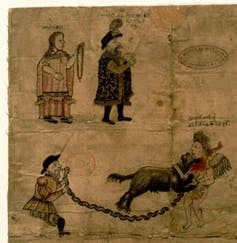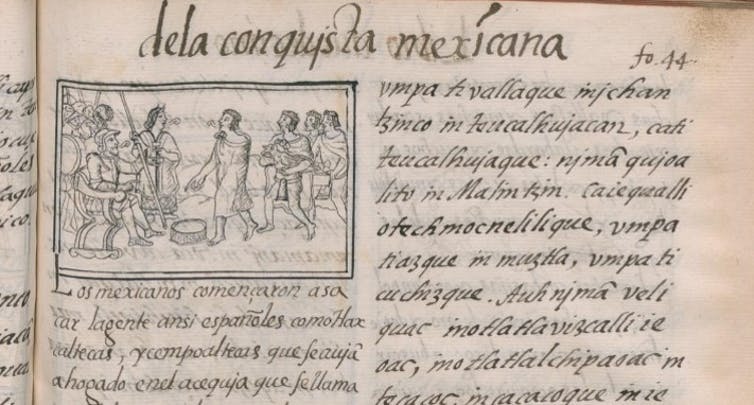Malintzin, Marina, Malinche. Three names for the same woman that she became the first indigenous woman from Mesoamerica to be the protagonist of her own history. We know little about her because the documentary sources that we have to reconstruct her life are scarce and repetitive and the author who could have provided us with the most information, Hernán Cortés, barely mentions her in his writings. She went from slave to interpreter of Extremadura, who used her gift of languages to negotiate and ally with the enemies of Moctezuma with the intention of conquering the Aztec empire.
We have filled hundreds of pages mythologizing Malintzin, imagining his words or feelings, but the reality is that we do not know his precise functions alongside Cortés, his daily work, apart from his job as faraute. There are not a few chroniclers of the Indies or the documents of indigenous origin that dedicate some lines to it, but there are also dozens who have related and portrayed its existence, including biographies, novels, essays, documentaries, paintings, operas or musicals.
The origins of Malinche
His origin is uncertain: we know that he was born around 1500 in Coatzacoalcos, a town near Veracruz. Perhaps he belonged to a local noble family: his parents were descendants of caciques, but his mother was widowed and joined another man with whom she had a son, after which Malintzin was given into servitude. However, this often repeated version should be mistrusted, because women of a distinguished lineage could enjoy other destinations, so it is possible to suspect that the story of the young noblewoman turned into a slave could have been concocted by the chroniclers to ennoble the figure of the servant of Cortés.
His encounter with the Spanish occurs in March 1519: the Chontal Mayan Indians (Tabasco), defeated in the battle of Centla, gave Hernán Cortés, in addition to precious stones, jewels or exotic feathers, several young women, among whom was Malintzin. This is how it is collected by chroniclers such as Bernal Díaz del Castillo in his True story of the conquest of New Spain.
>

Fragments preserved in the Nettie Lee Benson Library, University of Texas (Austin, USA), Author provided
In addition to learning Castile (Spanish), Malinche spoke Nahuatl as his mother tongue, Chontal Mayan and Yucatec Mayan, he could even know Popoluca, spoken in Oluta, languages that he could have learned in his childhood and through his stays in servitude or because Nahuatl worked as general language and it was customary for the tributaries of the Triple Alliance to learn it.
Cortés was initially accompanied as interpreters by the Maya Melchorejo and Juliancillo, who were not very skilled and did not speak Chontal Maya. Instead, Malinche was a polyglot. This condition made it possible for him to understand Yucatec Maya with Fray Jerónimo de Aguilar, until he was mastering Spanish and interpreting parliaments directly from Nahuatl.

Mexican collection of the National Library of France., Author provided
The reliability of Malinche’s translations is anyone’s guess. In particular, those that were related to complex concepts about the government of both states or the Nahua and Christian theologies or their ability to translate what the tacuilos they read in the amoxtli, the sacred books, the codices, a task that is made more difficult with the presence of an intermediate agent like Aguilar.
Bernal provides a very interesting piece of information: Aguilar, until his death, accompanied Malinche in interviews, along with Orteguilla, Cortés’s page. This does not mean that Malinche’s interpretive capacity, which the chroniclers repeat ad nauseam, ceases to be credible. The arrival in Tenochtitlan incorporated one more specialist to this meeting of translators, because Moctezuma was accompanied by the tlacoch cal catl, his second, a general who helped him in the interviews with foreigners.
The baptism of Malinalli Tenepal
The passage from Malintzin to Marina takes place with baptism, a rite of Christianization to which conquered individuals were subjected. The sacrament diluted the original being with a blow, being the first exercise of the colonial act that was practiced with the natives. Over the years, Malinche would receive the treatment of doña, a title that endows her figure with the usual respect in Spanish society.
Despite this, Malintzin’s name survives alongside Marina’s. The suffix “tzin” was the honorific way of addressing the person who was revered. Its evolution to Malinche arises from the difficulty of the Spanish to pronounce the group «tz», which they turned into a «ch». However, the name her parents gave her was Malinalli Tenepal (the one who speaks loquaciously).

Library Medicea Laurenciana of Florence (Sign. Med. Palat. 218-220)., Author provided
Cortés divides the women among his men and she is handed over to Alonso Hernández de Portocarrero. Malintzin, then, is only a woman’s body at the moment of contact. As happened with the rest of the slaves, we will not know to what extent These women were a sex toy from the Extremadura camp.
Portocarrero was fully trusted and died in prison around 1521 defending the interests of his captain. This debt probably led Cortés to protect his friend’s wife. Taking charge of an indigenous woman in the 16th century meant having sexual relations with her, whether or not they were consensual. Cortés used Malintzin as a communicator and as an object of pleasure. From there to saying that there was love, calling her lover or partner is a long distance.
From this union his son Martín was born, named after his grandfather, Martín Cortés de Monroy, and after his younger brother, Martín Cortés de Arellano, in 1522. It is strange that Malintzin did not have any more children – let’s not forget that he shared a roof with Cortés in Coyoacán a long season. She married Juan Jaramillo, another of the faithful of Cortés, whom she had favored with a rich encomienda in Cholula, in 1524. With him she had a daughter, María. Cortés managed to have Malinche’s son legitimized by Pope Clemente VII in 1529. Two years earlier, in 1527, Malinche died of a smallpox epidemic, or matlazahuatl, or maybe measles, or cololitlzi.
conclusion
Centuries later the figure of Malinche would become a myth and a symbol. Myth that is the result of romanticism and the search for national references that intellectuals and politicians undertook, references of the Mexican collective imagination necessary to build a nation after independence. At the end of the day, national pride is made from the memory of the past and there is a risk of exploiting history, of manipulating it.
Malinche is also a symbol of the new subject that arises after the conquest: the conquered and colonized woman, the “symbol of surrender”, as Octavio Paz said, “who represents the Indian women, fascinated, raped or seduced by the Spanish.” Hence the poet called Mexicans “the sons of Malinche.”
Izaskun Álvarez Cuartero, Senior Lecturer in the History of America, University of Salamanca
This article was originally published on The Conversation. read the original.
Reference-www.eleconomista.com.mx